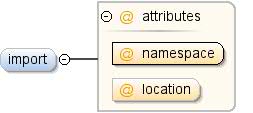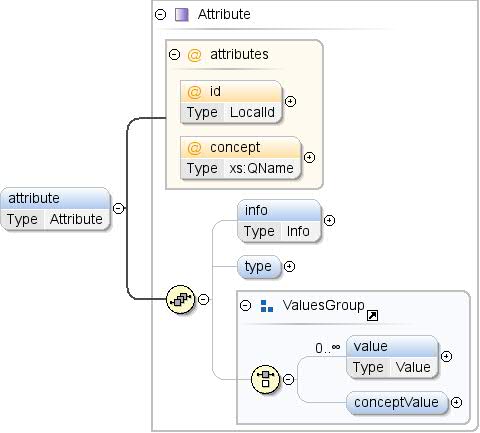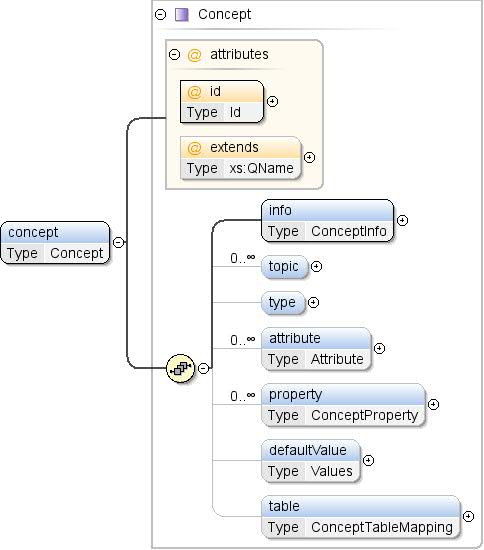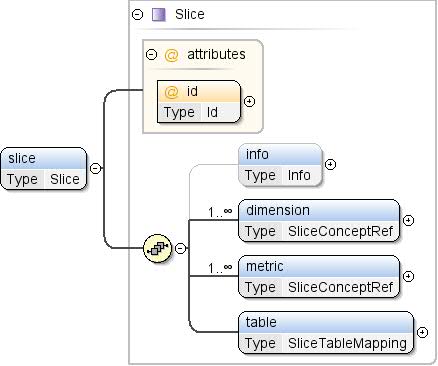DSPL スキーマ
コレクションでコンテンツを整理
必要に応じて、コンテンツの保存と分類を行います。
このページとリンク先のサブページでは、DSPL XML スキーマについて説明しています。
この資料は、Google Cloud のセキュリティと
言語の下位レベルの詳細。ほとんどのユーザーにとって、コンテンツは
(<ph type="x-smartling-placeholder"></ph>)
デベロッパー ガイドで作成、編集するのに十分
DSPL データセットを使用します。
完全な XML スキーマを XSD 形式でダウンロードできます。
<ph type="x-smartling-placeholder"></ph>
DSPL コードサイトをご覧ください。
要素: dspl
| 名前空間 |
http://schemas.google.com/dspl/2010 |
| アノテーション |
DSPL 仕様は、データセットを記述します。データセットとは、
Namespace で識別されます。データセットは
要素: - テーブル:
データセット - 概念: データセットで使用するユーザー指定の定義と構造
データセット - スライス: データセットに存在するディメンションと指標の組み合わせ
データセット - トピック: コンセプトを整理するために使用する階層ラベル
データセット |
| 図 |
 |
| プロパティ |
|
| モデル |
import*、info、provider、
attribute*、topics{0,1}、concepts{0,1}、スライス{0,1}、テーブル{0,1} |
| 子供 |
attribute、concepts、import、
情報、プロバイダ、スライス、
テーブル、トピック |
| インスタンス |
<dspl targetNamespace="">
<import location="" namespace="">{0,unbounded}</import>
<info>{1,1}</info>
<provider>{1,1}</provider>
<attribute concept="" id="">{0,unbounded}</attribute>
<topics>{0,1}</topics>
<concepts>{0,1}</concepts>
<slices>{0,1}</slices>
<tables>{0,1}</tables>
</dspl>
|
| 属性 |
| QName |
タイプ |
固定 |
デフォルト |
使用 |
Annotation |
| targetNamespace |
xs:anyURI |
|
|
省略可 |
各データセットは、ターゲット名前空間を指定できます。ターゲット
namespace は、データセットを一意に識別する URI です。詳細
XML での名前空間の使用については、以下をご覧ください。
http://www.w3.org/TR/REC-xml-names/ targetNamespace が
データセットの作成時に名前空間が生成される
インポートします。 |
|
| ソース |
<xs:element name="dspl">
<xs:annotation>
<xs:documentation>A DSPL specification describes a dataset. A dataset is
identified by its namespace. A dataset is comprised of the
following elements:
- Tables: Data for the concepts and slices defined in the
dataset
- Concepts: User-specified definitions and structures used in
the dataset
- Slices: Combinations of dimensions and metrics present in
the dataset
- Topics: Hierarchical labels used to organise the concepts of
the dataset</xs:documentation>
</xs:annotation>
<xs:complexType>
<xs:sequence>
<xs:element name="import" minOccurs="0" maxOccurs="unbounded">
<xs:annotation>
<xs:documentation>Import directive for external datasets -- modeled after
the XML Schema import directive. In order to use
elements defined in an external dataset, the external
dataset must be referenced using an import directive.</xs:documentation>
</xs:annotation>
<xs:complexType>
<xs:attribute name="namespace" use="required">
<xs:annotation>
<xs:documentation>The namespace of the imported dataset, specified as
a URI. A prefix must be associated with this
namespace before its contents can be referenced. See
[XML Namespaces] for more information about the use
of namespaces and prefixes in XML.</xs:documentation>
</xs:annotation>
</xs:attribute>
<xs:attribute name="location" use="optional">
<xs:annotation>
<xs:documentation>An optional location where the definition of the
imported dataset can be found, specified as a
URL. If the location is omitted, the system
processing this DSPL dataset must already know the
imported dataset.
Implementation note: The Google dataset importer
ignores the location attribute. Any imported dataset
must be known by the Google importer beforehand.</xs:documentation>
</xs:annotation>
</xs:attribute>
</xs:complexType>
</xs:element>
<xs:element name="info" type="Info" minOccurs="1">
<xs:annotation>
<xs:documentation>General information about the dataset.</xs:documentation>
</xs:annotation>
</xs:element>
<xs:element name="provider" type="Info">
<xs:annotation>
<xs:documentation>General information about the dataset provider.</xs:documentation>
</xs:annotation>
</xs:element>
<xs:element name="attribute" type="Attribute" minOccurs="0" maxOccurs="unbounded">
<xs:annotation>
<xs:documentation>Attribute associated with the dataset.</xs:documentation>
</xs:annotation>
</xs:element>
<xs:element name="topics" minOccurs="0">
<xs:annotation>
<xs:documentation>A hierarchy of topics used to organize the contents of
the dataset. The order in which topics are given is
meaningful and should be respected by visualizations
that displays these topics.</xs:documentation>
</xs:annotation>
<xs:complexType>
<xs:sequence>
<xs:element name="topic" type="Topic" maxOccurs="unbounded"/>
</xs:sequence>
</xs:complexType>
</xs:element>
<xs:element name="concepts" minOccurs="0">
<xs:annotation>
<xs:documentation>A list of concepts defined in this dataset.</xs:documentation>
</xs:annotation>
<xs:complexType>
<xs:sequence>
<xs:element name="concept" type="Concept" maxOccurs="unbounded"/>
</xs:sequence>
</xs:complexType>
</xs:element>
<xs:element name="slices" minOccurs="0">
<xs:annotation>
<xs:documentation>A list of slices defined in this dataset.</xs:documentation>
</xs:annotation>
<xs:complexType>
<xs:sequence>
<xs:element name="slice" type="Slice" maxOccurs="unbounded"/>
</xs:sequence>
</xs:complexType>
</xs:element>
<xs:element name="tables" minOccurs="0">
<xs:annotation>
<xs:documentation>A list of tables defined in this dataset.</xs:documentation>
</xs:annotation>
<xs:complexType>
<xs:sequence>
<xs:element name="table" type="Table" maxOccurs="unbounded"/>
</xs:sequence>
</xs:complexType>
</xs:element>
</xs:sequence>
<xs:attribute name="targetNamespace" type="xs:anyURI" use="optional">
<xs:annotation>
<xs:documentation>Each dataset may provide a target namespace. The
target namespace is a URI that uniquely identifies the
dataset. For more information about the use of namespaces in XML,
see:
http://www.w3.org/TR/REC-xml-names/
If no targetNamespace is provided, then a namespace will be
generated when the dataset is imported.</xs:documentation>
</xs:annotation>
</xs:attribute>
</xs:complexType>
</xs:element>
|
要素: dspl / import
| 名前空間 |
http://schemas.google.com/dspl/2010 |
| アノテーション |
外部データセット用のインポート ディレクティブ -- XML に従ってモデル化
スキーマ インポート ディレクティブ。外部環境変数で定義された要素を使用するには、
外部データセットは、インポートを使用して参照する必要があります。
ディレクティブを使用。 |
| 図 |
 |
| プロパティ |
| content: |
複雑 |
| minOccurs: |
0 |
| maxOccurs: |
制限なし |
|
| 属性 |
| QName |
タイプ |
固定 |
デフォルト |
使用 |
Annotation |
| location |
|
|
|
省略可 |
インポートされた
URL として指定できます。地域が
省略した場合は、この DSPL データセットを処理するシステムが、
表します。実装に関する注意事項: Google データセット
インポータは location 属性を無視します。インポートしたデータセットは、
事前に Google の輸入業者に知らせておいてください。 |
| namespace |
|
|
|
必須 |
インポートされたデータセットの名前空間。
URI です。この Namespace の前に接頭辞を関連付ける必要があります
コンテンツを参照できます。詳細については、[XML Namespaces] をご覧ください。
名前空間と接頭辞の使用に関する情報が
XML |
|
| ソース |
<xs:element name="import" minOccurs="0" maxOccurs="unbounded">
<xs:annotation>
<xs:documentation>Import directive for external datasets -- modeled after
the XML Schema import directive. In order to use
elements defined in an external dataset, the external
dataset must be referenced using an import directive.</xs:documentation>
</xs:annotation>
<xs:complexType>
<xs:attribute name="namespace" use="required">
<xs:annotation>
<xs:documentation>The namespace of the imported dataset, specified as
a URI. A prefix must be associated with this
namespace before its contents can be referenced. See
[XML Namespaces] for more information about the use
of namespaces and prefixes in XML.</xs:documentation>
</xs:annotation>
</xs:attribute>
<xs:attribute name="location" use="optional">
<xs:annotation>
<xs:documentation>An optional location where the definition of the
imported dataset can be found, specified as a
URL. If the location is omitted, the system
processing this DSPL dataset must already know the
imported dataset.
Implementation note: The Google dataset importer
ignores the location attribute. Any imported dataset
must be known by the Google importer beforehand.</xs:documentation>
</xs:annotation>
</xs:attribute>
</xs:complexType>
</xs:element>
|
要素: dspl / info
| 名前空間 |
http://schemas.google.com/dspl/2010 |
| アノテーション |
データセットに関する一般的な情報。 |
| 図 |
 |
| タイプ |
情報 |
| プロパティ |
|
| モデル |
name、description{0,1}、url{0,1} |
| 子供 |
description、name、url |
| インスタンス |
<info>
<name>{1,1}</name>
<description>{0,1}</description>
<url>{0,1}</url>
</info>
|
| ソース |
<xs:element name="info" type="Info" minOccurs="1">
<xs:annotation>
<xs:documentation>General information about the dataset.</xs:documentation>
</xs:annotation>
</xs:element>
|
要素: dspl / provider
| 名前空間 |
http://schemas.google.com/dspl/2010 |
| アノテーション |
データセット プロバイダに関する一般的な情報。 |
| 図 |
 |
| タイプ |
情報 |
| プロパティ |
|
| モデル |
name、description{0,1}、url{0,1} |
| 子供 |
description、name、url |
| インスタンス |
<provider>
<name>{1,1}</name>
<description>{0,1}</description>
<url>{0,1}</url>
</provider>
|
| ソース |
<xs:element name="provider" type="Info">
<xs:annotation>
<xs:documentation>General information about the dataset provider.</xs:documentation>
</xs:annotation>
</xs:element>
|
要素: dspl / 属性
| 名前空間 |
http://schemas.google.com/dspl/2010 |
| アノテーション |
データセットに関連付けられた属性。 |
| 図 |
 |
| タイプ |
属性 |
| プロパティ |
| content: |
複雑 |
| minOccurs: |
0 |
| maxOccurs: |
制限なし |
|
| モデル |
info{0,1}、type{0,1}、(value*
|conceptValue{0,1}) |
| 子供 |
conceptValue、info、type、
値 |
| インスタンス |
<attribute concept="" id="">
<info>{0,1}</info>
<type format="" ref="">{0,1}</type>
</attribute>
|
| 属性 |
| QName |
タイプ |
固定 |
デフォルト |
使用 |
Annotation |
| コンセプト |
xs:QName |
|
|
省略可 |
値に対応するコンセプトへの参照
使用します。属性でタイプが指定されている場合、そのタイプは
参照されるコンセプトのタイプと一致している必要があります。参照:
外部コンセプトは、
"prefix:other_concept_id"("prefix")
外部データセットの名前空間に使用される接頭辞(XML を参照
実装します。 |
| id |
LocalId |
|
|
省略可 |
コンセプト属性の ID。この識別子は、
(属性とプロパティ全体で)一意でなければなりません。「
concept 属性が指定されている場合、id は省略できます。その
場合、ID は、そのサービスのローカル名の値で暗黙的に作成されます。
参照されるコンセプトです。例: <attribute
concept="unit:currency"/>は次と同等です:
<attribute id="currency"
concept="unit:currency"/> |
|
| ソース |
<xs:element name="attribute" type="Attribute" minOccurs="0" maxOccurs="unbounded">
<xs:annotation>
<xs:documentation>Attribute associated with the dataset.</xs:documentation>
</xs:annotation>
</xs:element>
|
要素: dspl / トピック
| 名前空間 |
http://schemas.google.com/dspl/2010 |
| アノテーション |
トピックの階層構造で、
見てみましょう。トピックを指定する順序には意味があり、順序は
これらのトピックを表示する可視化で尊重されます。 |
| 図 |
 |
| プロパティ |
|
| モデル |
トピック + |
| 子供 |
トピック |
| インスタンス |
<topics>
<topic id="" parentTopic="">{1,unbounded}</topic>
</topics>
|
| ソース |
<xs:element name="topics" minOccurs="0">
<xs:annotation>
<xs:documentation>A hierarchy of topics used to organize the contents of
the dataset. The order in which topics are given is
meaningful and should be respected by visualizations
that displays these topics.</xs:documentation>
</xs:annotation>
<xs:complexType>
<xs:sequence>
<xs:element name="topic" type="Topic" maxOccurs="unbounded"/>
</xs:sequence>
</xs:complexType>
</xs:element>
|
| 名前空間 |
http://schemas.google.com/dspl/2010 |
| 図 |
 |
| タイプ |
トピック |
| プロパティ |
| content: |
複雑 |
| maxOccurs: |
制限なし |
|
| モデル |
info、topic* |
| 子供 |
info、topic |
| インスタンス |
<topic id="" parentTopic="">
<info>{1,1}</info>
<topic id="" parentTopic="">{0,unbounded}</topic>
</topic>
|
| 属性 |
| QName |
タイプ |
固定 |
デフォルト |
使用 |
Annotation |
| id |
ID |
|
|
必須 |
トピックの一意の識別子は、
説明します。 |
| parentTopic |
xs:QName |
|
|
省略可 |
このトピックの親トピックの ID(ある場合)。
内部にインライン化されているトピックには parentTopic を指定できません。
その他のトピックをご覧ください。 |
|
| ソース |
<xs:element name="topic" type="Topic" maxOccurs="unbounded"/>
|
要素: dspl / コンセプト
| 名前空間 |
http://schemas.google.com/dspl/2010 |
| アノテーション |
このデータセットで定義されているコンセプトのリスト。 |
| 図 |
 |
| プロパティ |
|
| モデル |
コンセプト+ |
| 子供 |
コンセプト |
| インスタンス |
<concepts>
<concept extends="" id="">{1,unbounded}</concept>
</concepts>
|
| ソース |
<xs:element name="concepts" minOccurs="0">
<xs:annotation>
<xs:documentation>A list of concepts defined in this dataset.</xs:documentation>
</xs:annotation>
<xs:complexType>
<xs:sequence>
<xs:element name="concept" type="Concept" maxOccurs="unbounded"/>
</xs:sequence>
</xs:complexType>
</xs:element>
|
| 名前空間 |
http://schemas.google.com/dspl/2010 |
| 図 |
 |
| タイプ |
コンセプト |
| プロパティ |
| content: |
複雑 |
| maxOccurs: |
制限なし |
|
| モデル |
info、topic*、type{0,1}、
attribute*、property*、defaultValue{0,1}、table{0,1} |
| 子供 |
attribute、defaultValue、info、
property、table、topic、
タイプ |
| インスタンス |
<concept extends="" id="">
<info>{1,1}</info>
<topic ref="">{0,unbounded}</topic>
<type ref="">{0,1}</type>
<attribute concept="" id="">{0,unbounded}</attribute>
<property concept="" id="" isMapping="false" isParent="false">{0,unbounded}</property>
<defaultValue>{0,1}</defaultValue>
<table ref="">{0,1}</table>
</concept>
|
| 属性 |
| QName |
タイプ |
固定 |
デフォルト |
使用 |
Annotation |
| 延長 |
xs:QName |
|
|
省略可 |
このコンセプトが持つコンセプトの一意の識別子
あります。参照されるコンセプトは、同じデータセットで定義できます。
外部、つまり別のデータセットです。外部 ID への参照は、
コンセプトは「prefix:other_concept_id」の形式にする必要があります。
「接頭辞」はは、名前の名前空間に使用される接頭辞です。
外部データセット(XML 名前空間を参照) |
| id |
ID |
|
|
必須 |
コンセプトを一意に識別する ID。
データセット内でグローバルに一意です |
|
| ソース |
<xs:element name="concept" type="Concept" maxOccurs="unbounded"/>
|
要素: dspl / slices
| 名前空間 |
http://schemas.google.com/dspl/2010 |
| アノテーション |
このデータセットで定義されているスライスのリスト。 |
| 図 |
 |
| プロパティ |
|
| モデル |
スライス + |
| 子供 |
slice |
| インスタンス |
<slices>
<slice id="">{1,unbounded}</slice>
</slices>
|
| ソース |
<xs:element name="slices" minOccurs="0">
<xs:annotation>
<xs:documentation>A list of slices defined in this dataset.</xs:documentation>
</xs:annotation>
<xs:complexType>
<xs:sequence>
<xs:element name="slice" type="Slice" maxOccurs="unbounded"/>
</xs:sequence>
</xs:complexType>
</xs:element>
|
| 名前空間 |
http://schemas.google.com/dspl/2010 |
| 図 |
 |
| タイプ |
スライス |
| プロパティ |
| content: |
複雑 |
| maxOccurs: |
制限なし |
|
| モデル |
info{0,1}、dimension+、metric+
、テーブル |
| 子供 |
dimension、info、metric、
テーブル |
| インスタンス |
<slice id="">
<info>{0,1}</info>
<dimension concept="">{1,unbounded}</dimension>
<metric concept="">{1,unbounded}</metric>
<table ref="">{1,1}</table>
</slice>
|
| 属性 |
| QName |
タイプ |
固定 |
デフォルト |
使用 |
Annotation |
| id |
ID |
|
|
必須 |
スライスの一意の識別子。 |
|
| ソース |
<xs:element name="slice" type="Slice" maxOccurs="unbounded"/>
|
要素: dspl / Tables
| 名前空間 |
http://schemas.google.com/dspl/2010 |
| アノテーション |
このデータセットで定義されているテーブルのリスト。 |
| 図 |
 |
| プロパティ |
|
| モデル |
テーブル+ |
| 子供 |
テーブル |
| インスタンス |
<tables>
<table id="">{1,unbounded}</table>
</tables>
|
| ソース |
<xs:element name="tables" minOccurs="0">
<xs:annotation>
<xs:documentation>A list of tables defined in this dataset.</xs:documentation>
</xs:annotation>
<xs:complexType>
<xs:sequence>
<xs:element name="table" type="Table" maxOccurs="unbounded"/>
</xs:sequence>
</xs:complexType>
</xs:element>
|
| 名前空間 |
http://schemas.google.com/dspl/2010 |
| 図 |
 |
| タイプ |
テーブル |
| プロパティ |
| content: |
複雑 |
| maxOccurs: |
制限なし |
|
| モデル |
info{0,1}、column+、data{0,1} |
| 子供 |
列、データ、情報 |
| インスタンス |
<table id="">
<info>{0,1}</info>
<column format="" id="" type="">{1,unbounded}</column>
<data>{0,1}</data>
</table>
|
| 属性 |
| QName |
タイプ |
固定 |
デフォルト |
使用 |
Annotation |
| id |
ID |
|
|
必須 |
テーブルに含まれるテーブルの一意の識別子
説明します。 |
|
| ソース |
<xs:element name="table" type="Table" maxOccurs="unbounded"/>
|
| 名前空間 |
名前空間がありません |
| アノテーション |
インポートされたデータセットの名前空間。URI として指定されます。
接頭辞をこの名前空間に関連付ける必要があります。関連付ける必要があります。
あります。名前空間の使用に関する詳細については、[XML 名前空間] を参照してください。
XML の名前空間と接頭辞。 |
| プロパティ |
|
| 使用者 |
|
| ソース |
<xs:attribute name="namespace" use="required">
<xs:annotation>
<xs:documentation>The namespace of the imported dataset, specified as
a URI. A prefix must be associated with this
namespace before its contents can be referenced. See
[XML Namespaces] for more information about the use
of namespaces and prefixes in XML.</xs:documentation>
</xs:annotation>
</xs:attribute>
|
| 名前空間 |
名前空間がありません |
| アノテーション |
インポートされた
URL として指定できます。ロケーションを省略すると、
この DSPL データセットを処理するシステムは、インポートされた
見てみましょう。実装に関する注意事項: Google データセット インポータは
location 属性。インポートされたデータセットはすべて、Google に認識されている必要があります
事前に確認する必要があります。 |
| プロパティ |
|
| 使用者 |
|
| ソース |
<xs:attribute name="location" use="optional">
<xs:annotation>
<xs:documentation>An optional location where the definition of the
imported dataset can be found, specified as a
URL. If the location is omitted, the system
processing this DSPL dataset must already know the
imported dataset.
Implementation note: The Google dataset importer
ignores the location attribute. Any imported dataset
must be known by the Google importer beforehand.</xs:documentation>
</xs:annotation>
</xs:attribute>
|
属性: dspl / @targetNamespace
| 名前空間 |
名前空間がありません |
| アノテーション |
各データセットは、ターゲット名前空間を提供できます。ターゲット
namespace は、データセットを一意に識別する URI です。詳細
XML での名前空間の使用については、以下をご覧ください。
http://www.w3.org/TR/REC-xml-names/ targetNamespace が指定されていない場合、
データセットが作成されたときに名前空間が
インポートします。 |
| タイプ |
xs:anyURI |
| プロパティ |
|
| 使用者 |
|
| ソース |
<xs:attribute name="targetNamespace" type="xs:anyURI" use="optional">
<xs:annotation>
<xs:documentation>Each dataset may provide a target namespace. The
target namespace is a URI that uniquely identifies the
dataset. For more information about the use of namespaces in XML,
see:
http://www.w3.org/TR/REC-xml-names/
If no targetNamespace is provided, then a namespace will be
generated when the dataset is imported.</xs:documentation>
</xs:annotation>
</xs:attribute>
|
次を使用して作成:
oXygen XML エディタ。
特に記載のない限り、このページのコンテンツはクリエイティブ・コモンズの表示 4.0 ライセンスにより使用許諾されます。コードサンプルは Apache 2.0 ライセンスにより使用許諾されます。詳しくは、Google Developers サイトのポリシーをご覧ください。Java は Oracle および関連会社の登録商標です。
最終更新日 2025-07-25 UTC。
[null,null,["最終更新日 2025-07-25 UTC。"],[],["The DSPL XML schema defines a dataset's structure using key components: `tables`, `concepts`, `slices`, and `topics`. The root `dspl` element encapsulates the dataset, utilizing `import` to reference externals, `info` and `provider` for metadata, `attribute` for dataset attributes, and `topics` to hierarchically organize the concepts. `concepts`, `slices`, `tables` are for concept definition, slice definition, and data table, respectively. Each element like `import`, `info`, `provider`, `attribute`, `topic`, `concept`, `slice`, `table` uses specific attributes and child elements for configuration. Each element has a specific cardinality that is defined in the document.\n"]]












